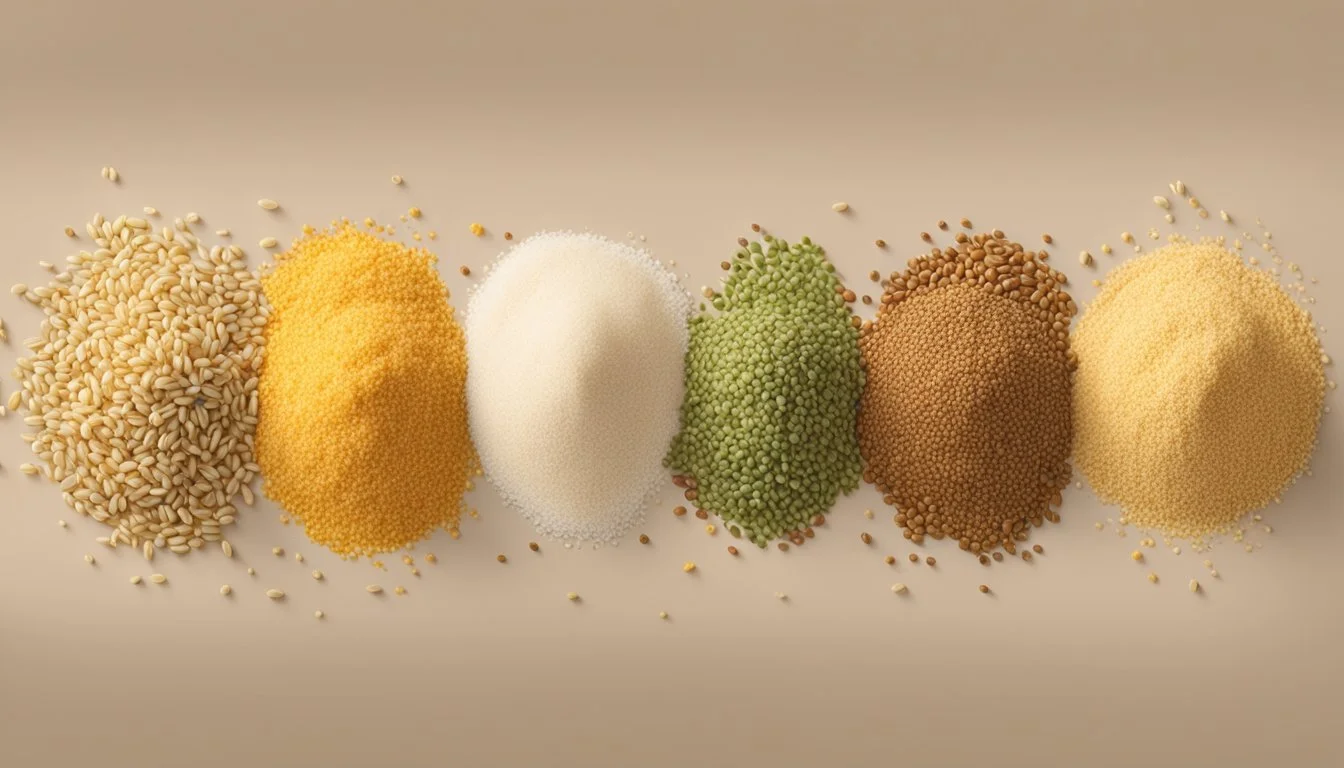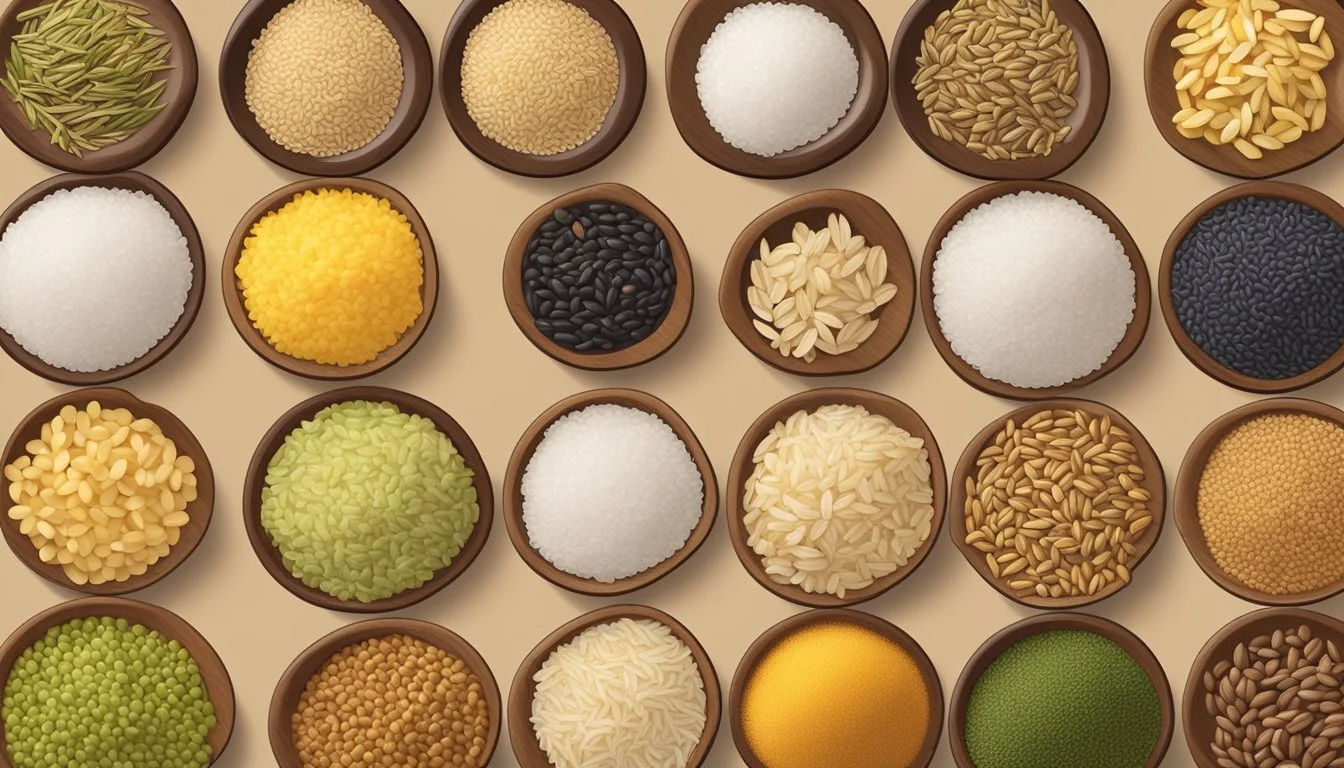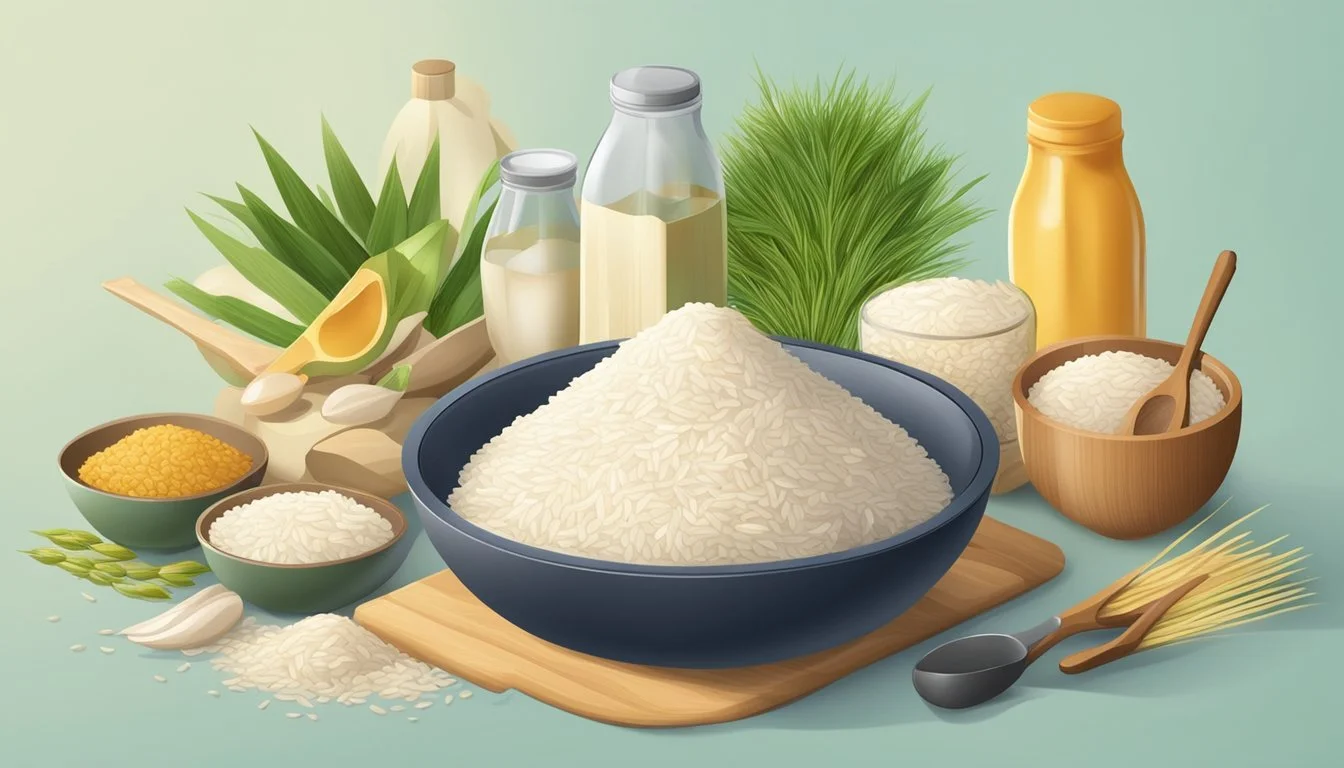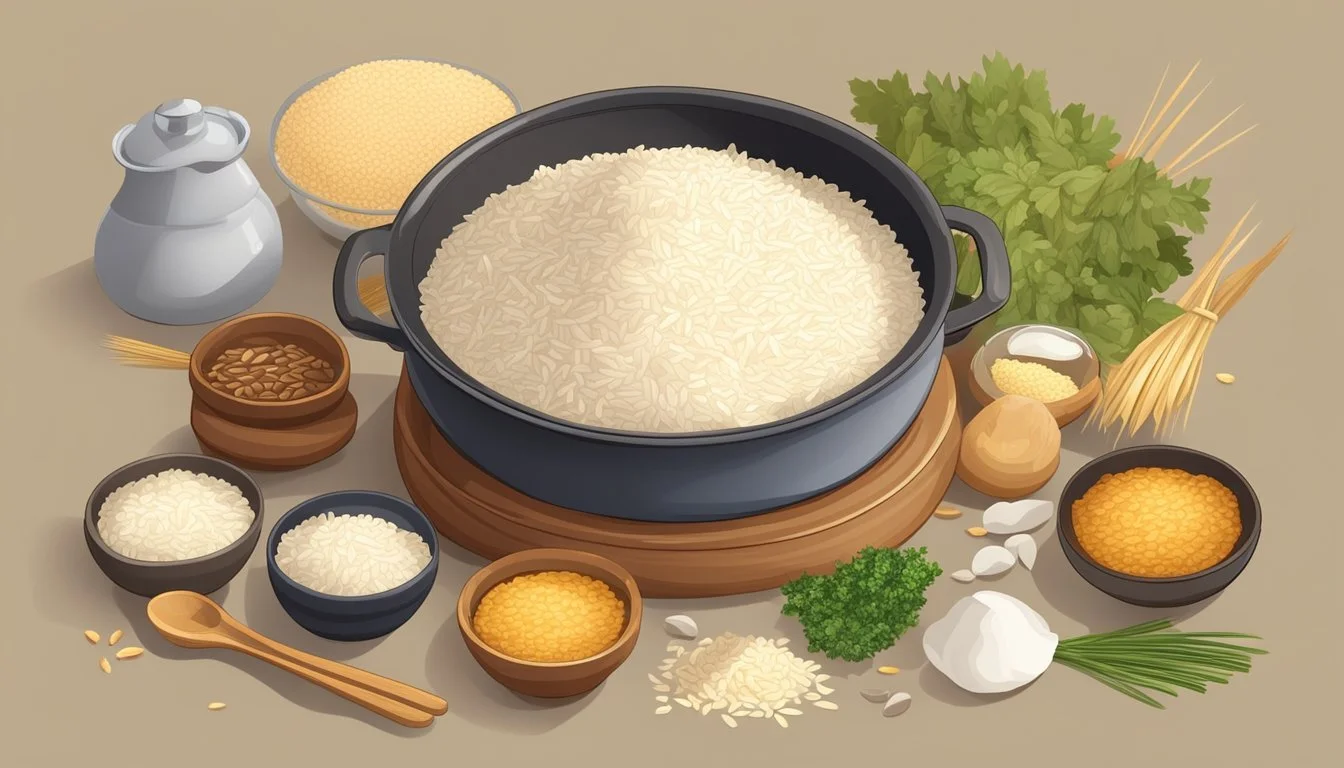Parboiled Rice Substitutes
Top Alternatives for Your Diet
Finding the right substitutes for parboiled rice can be crucial for perfecting your recipes. Some of the best alternatives include couscous, quinoa, farro, brown rice, and buckwheat groats. Couscous is an excellent choice for those seeking a quick-cooking option, while brown rice ranks as the top substitute in terms of nutritional value.
Parboiled rice, also known as converted rice, undergoes a unique process that results in a firmer, less sticky texture, making it ideal for dishes like pilafs, casseroles, and stir-frys. Regular rice can be used in place of parboiled rice, but it's essential to note that the texture and cooking time may vary. For those looking to maintain a similar nutritional profile, brown rice is highly recommended.
When it comes to incorporating these substitutes in your meals, it helps to understand the distinct advantages each option offers. Quinoa, for instance, provides a protein-packed alternative, while farro adds a chewy texture and nutty flavor to savory dishes. Buckwheat groats bring a unique earthy taste and are particularly suitable for recipes that benefit from a robust grain. Use these substitutes to keep your cooking versatile and nutritionally balanced.
Understanding Parboiled Rice
Parboiled rice undergoes a unique processing method that impacts its texture, nutritional content, and cooking characteristics. This section covers its definition, nutritional benefits, and the detailed steps involved in parboiling.
What Is Parboiled Rice
Parboiled rice is rice that has been partially boiled in the husk before milling. This is distinct from regular white rice or brown rice. The key steps include soaking, steaming, and drying while the rice is still in its inedible husk. This process alters the physical and chemical properties of the rice, creating a firm texture and a distinctive yellow hue.
Parboiled rice is less sticky than regular rice when cooked. This makes it ideal for making dishes that require separate grains like pilaf and curry. It is also less prone to overcooking.
Nutritional Benefits of Parboiled Rice
Parboiled rice offers several nutritional benefits over regular white rice. The parboiling process drives nutrients from the outer bran layer into the starchy endosperm.
Fiber Content: Parboiled rice contains more fiber, which aids in digestion and helps maintain a healthy weight. A 155-gram serving provides about 1 gram of fiber.
Vitamins and Minerals: The process helps retain more vitamins and minerals, like B vitamins and magnesium, than regular white rice. The fortified grain is more nutritious, contributing to better overall health.
This nutrient retention makes parboiled rice a healthier option for those looking to incorporate more balanced foods into their diets.
The Parboiling Process
Parboiling involves a three-step method: soaking, steaming, and drying.
Soaking: Grains are soaked in water to hydrate.
Steaming: Soaked rice is then steamed. This step gelatinizes the starch, hardening the grains and pushing nutrients from the husk into the endosperm.
Drying: Finally, the rice is dried to reduce moisture content before milling.
After drying, the rice is milled to remove the husk. This unique process retains more nutrients and results in a firmer, less sticky texture when cooked, making it suitable for a variety of culinary uses.
Requirements For A Good Substitute
When selecting a substitute for parboiled rice, it is crucial to consider factors such as texture, flavor profiles, nutritional values, and compatibility with various cooking methods. Each of these aspects plays a significant role in ensuring that the substitute will meet expectations in diverse culinary applications.
Similar Texture and Flavor Profiles
A good substitute should closely mimic the texture and flavor of parboiled rice. Parboiled rice has a firm, non-sticky texture and a mild, slightly nutty flavor. Suitable candidates might include quinoa, couscous, or bulgur wheat. These grains cook up firm and absorb flavors well.
Quinoa is particularly effective due to its similar texture and slightly nutty taste. Couscous, although smaller in size, provides a comparable mouthfeel. Bulgur wheat not only offers the firm texture required but also has flavor nuances that align well with many dishes typically made with parboiled rice.
Nutritional Considerations
Nutritional benefits are equally important when choosing a substitute. Parboiled rice is rich in vitamins and minerals like thiamine and niacin. Alternatives such as quinoa, farro, and barley are also nutrient-dense. Quinoa, for instance, is high in protein, fiber, and essential amino acids, making it a well-rounded substitute.
Farro and barley are high in fiber and additional minerals, thus offering health benefits comparable to parboiled rice. Furthermore, these grains contain complex carbohydrates, which help in maintaining stable blood sugar levels. Ensuring the substitute’s nutritional profile matches or exceeds that of parboiled rice can greatly enhance dietary quality.
Cooking Time and Method Compatibility
Parboiled rice's versatility extends to its cooking convenience, being suitable for methods such as boiling, using a rice cooker, and including in oven-baked casseroles. Efficient substitutes should have similar cooking times and adapt well to these methods.
Quinoa cooks in about 15-20 minutes, making it quick and convenient. Instant rice varieties can be an alternative too, particularly when time is of the essence. Some substitutes may adapt well to microwave preparation, making them suitable for quick meals. Attention to aisle-specific cooking times ensures ease during meal preparation. Bulgur wheat, depending on the coarseness, can also provide a convenient cooking timeline, aligning well with various cooking tools and methods.
By considering texture, flavor, nutritional value, and cooking convenience, one can find a suitable substitute that fulfills the requirements for replacing parboiled rice in a variety of dishes.
Popular Rice Substitutes
When looking for alternatives to parboiled rice, there are numerous options available, each with its unique cooking times, textures, and flavors. Here are some popular substitutes to consider, ranging from the familiar white and brown rice to more specialized varieties.
White Rice and Its Varieties
White rice is a versatile substitute. Long-grain white rice is less sticky and ideal for pilafs. Short-grain white rice, akin to Japanese sushi rice, has a stickier texture, making it suitable for dishes like sushi or rice pudding.
Converted rice, also known as parboiled rice, is partially boiled in the husk, retaining more nutrients than regular white rice. Jasmine and Basmati rice are aromatic long-grain varieties. Jasmine rice has a softer texture, while Basmati elongates significantly when cooked, suitable for dishes like biryani.
Brown Rice: A Whole Grain Alternative
Brown rice retains its bran and germ, offering more fiber and nutrients. Available in short-grain and long-grain varieties, brown rice has a chewier texture and a nutty flavor.
Long-grain brown rice is less sticky and great for stir-fries, while short-grain brown rice has a denser texture, perfect for creamy dishes. Brown rice takes longer to cook and requires more water but provides a more nutritious alternative to white rice.
Specialty Rices for Unique Dishes
For those seeking unique flavors and textures, specialty rices offer exciting alternatives. Black rice (or forbidden rice) has a rich, nutty taste and high anthocyanin content, making it a nutritious option.
Wild rice, actually a water grass seed, has a chewy texture and earthy flavor. Arborio rice is crucial for making risotto due to its creamy texture when cooked. Bomba rice, a Spanish short-grain rice, is used for paella, absorbing flavors while maintaining firmness.
These specialty rices can elevate dishes with distinct textures and flavors, providing exciting culinary possibilities beyond parboiled rice.
Non-Rice Grain Substitutes
When looking for non-rice grain substitutes, it is essential to consider options that offer unique flavors and nutritional benefits. Two categories to explore are nutty-flavored grains and gluten-free grain options.
Nutty Flavored Grains
Farro and barley are excellent examples of nutty-flavored grains.
Farro is an ancient grain known for its chewy texture and rich, nutty taste. It is a whole grain that provides a good amount of protein and fiber, making it a nutritious alternative to parboiled rice. In a serving, farro offers vital minerals such as iron and magnesium, which are essential for maintaining good health.
Barley boasts a slightly chewy texture and nutty flavor. It is often used in soups and stews. Barley is a whole grain that is high in fiber and contains essential vitamins and minerals. It can help in controlling blood sugar levels and improving digestive health due to its high-fiber content. Both grains absorb flavors beautifully and can be used in various savory and sweet dishes.
Gluten-Free Grain Options
For those needing gluten-free alternatives, options like quinoa, buckwheat groats, and bulgur are excellent choices.
Quinoa is a high-protein, gluten-free grain that cooks quickly. It is rich in essential minerals such as iron and magnesium, making it a nutritious substitute. Quinoa's ability to absorb flavors makes it versatile for different cuisines.
Buckwheat groats are another gluten-free option with a slightly earthy flavor and a soft texture when cooked. This grain is rich in protein, fiber, and antioxidants, contributing to various health benefits. It fits well into dishes where a hearty texture and flavor are desired.
Bulgur is a quick-cooking grain often used in Middle Eastern cuisine. It has a mild, nutty flavor and is packed with fiber. Although it generally contains gluten, there are gluten-free versions available. Bulgur can work well in salads, stews, and pilafs, offering a healthy alternative to traditional rice.
Vegetable-Based Substitutes
Vegetable-based substitutes for parboiled rice offer nutritious and low-calorie options. They are ideal for those looking to boost fiber intake, maintain a gluten-free diet, or manage diabetes.
Cauliflower and Other Riced Vegetables
Cauliflower rice is one of the most popular swaps for parboiled rice. It’s made by grating or processing cauliflower florets until they resemble rice grains. This low-calorie option is rich in fiber and nutrients, making it a healthy alternative.
Riced broccoli is another great choice. It offers a similar texture and is packed with vitamins and antioxidants. Both of these riced vegetables can be used in a variety of dishes, from side dishes to sushi and rice salads.
Benefits of Vegetable Rice Alternatives
Vegetable rice alternatives such as cauliflower rice and riced broccoli provide several benefits. They are low in calories and high in fiber, which is beneficial for weight management and digestive health. These substitutes are also naturally gluten-free, making them suitable for those with gluten sensitivities.
Moreover, vegetable-based rice alternatives have a low glycemic index, which is advantageous for individuals with diabetes. The vitamins and minerals found in these vegetables contribute to overall health, providing essential nutrients without adding a significant calorie load. This makes them an excellent choice for various culinary applications.
Convenience-Focused Alternatives
When time is of the essence, replacing parboiled rice with quicker cooking options or ready-made solutions can save valuable minutes in the kitchen. Review the following alternatives to streamline meal preparation without compromising quality.
Quick Cooking Rice Styles
Instant Rice: Instant rice offers a major time-saving advantage. It typically requires only 5-10 minutes to prepare, making it ideal for busy schedules. Simply add hot water or use the microwave to rehydrate the rice.
Calrose Rice: Calrose rice, a medium-grain variety, achieves a desirable creamy texture within a short cooking period. This makes it suitable not only for quick dinners but also for dishes demanding a risotto-like consistency.
Couscous: Although not technically rice, couscous is a quick-cooking grain that substitutes well in many rice dishes. It is ready in about 5 minutes by adding boiling water, and it absorbs flavors effectively.
Pre-Prepared and Instant Rice Solutions
Microwaveable Rice Packets: Pre-cooked microwaveable rice packets are a convenient option for those in a rush. Available in various types such as jasmine, basmati, and brown rice, these packets typically heat up in 90 seconds, offering both speed and versatility.
Instant Pot Rice: Using an Instant Pot can significantly reduce the cooking time for rice. Certain quick-cooking rice brands are designed for this appliance, providing fluffy, evenly-cooked results in as little as 10 minutes, including pressure build-up time.
Quinoa: For a high-protein, easy-to-prepare alternative, quinoa cooks in just 15-20 minutes and can serve as a nutritious substitute for any dish that would typically use parboiled rice. Pre-rinsed varieties cut down on prep time even further.
Considering Allergies and Dietary Restrictions
Individuals with rice allergies or specific dietary restrictions need suitable alternatives to parboiled rice. Key considerations include allergen-free options and dietary needs such as low-carb or gluten-free requirements.
Allergen-Free Options
For those with rice allergies, finding rice substitutes free of common allergens is crucial. Quinoa stands out as an excellent alternative. It's naturally gluten-free and provides a high protein content, making it nutritious and safe for many allergen sufferers.
Buckwheat is another viable choice despite its name. It's gluten-free and rich in fiber, but it can be an allergen for some, so it's essential to check for individual tolerance.
Amaranth and teff are lesser-known grains that are free from common allergens, providing fiber and essential nutrients without posing a risk to those with rice allergies.
Allergen-Free Rice Alternatives Nutritional Benefits Quinoa High protein, gluten-free Buckwheat Rich in fiber, gluten-free Amaranth High in protein, gluten-free Teff Rich in fiber, gluten-free
Options for Restricted Diets
For those needing low-carb or keto-friendly options, cauliflower rice offers significant benefits. It's extremely low in calories and carbohydrates, making it suitable for diabetes management and weight control diets.
Zucchini noodles (zoodles) can replace grains and are also low in carbs while providing hydration and nutrients.
Couscous and bulgur wheat are higher in carbs but are robust options for those not needing low-carb solutions. They are rich in fiber and essential nutrients.
Individuals with dietary restrictions, including gluten intolerance, can rely on gluten-free grains like millet and sorghum. These grains provide nutritional value and maintain dietary requirements without sacrificing taste or texture.
Dietary Restriction Rice Substitute Key Nutritional Feature Low-carb/Keto Cauliflower rice Low calorie, low carb Gluten intolerance Millet, sorghum Gluten-free High fiber preference Bulgur wheat, couscous High fiber
Cooking Techniques for Rice Substitutes
Proper techniques are essential for cooking substitutes of parboiled rice. Key considerations include water-to-rice ratio, cooking methods, and incorporating seasonings and flavor enhancers.
Water-To-Rice Ratio and Soaking
Different rice types and substitutes require specific water-to-rice ratios, impacting their texture and cooking time. For instance, basmati rice often uses a 1:1.5 ratio, whereas brown rice might need a 1:2.5 ratio due to its denser bran layer.
Other substitutes like quinoa require a 1:2 ratio. Soaking rice or other grains before cooking can shorten the overall cooking time and improve texture. Commonly, soaking brown rice for 30 minutes or more helps to soften it and reduce cooking time.
Use less water for stickier textures and more water for fluffier results.
Adapting Cooking Methods
Adapting cooking methods for different rice substitutes ensures consistency. Rice cookers are versatile and often adjustable for various rice types. For example, jasmine rice cooks well with standard white rice settings, while converted rice might need additional water and time.
Stovetop cooking allows more flexibility. Instant rice typically needs a rolling boil for a few minutes followed by steaming. Microwave cooking can be adjusted by increasing power settings but observing closely to prevent overcooking.
Each method has its unique advantages suited for specific rice types and cooking environments.
Seasonings and Flavor Enhancers
Enhancing flavor involves basic seasonings or more complex spice blends. Salt, pepper, and olive oil can improve basic taste profiles. Adding bay leaves or cardamom pods during boiling infuses additional flavors.
For a more robust flavor, substitute water with chicken or vegetable broth. Ingredients like saffron, turmeric, or cumin can add color and depth.
Experimenting with herbs like thyme or rosemary and aromatic vegetables such as onions and garlic enhances the overall taste. Soy sauce or vinegar can add umami or tangy notes to the rice or grain dishes.
Integrating Substitutes into Specific Dishes
Using rice substitutes can enhance flavor and nutrition in traditional dishes. Below, various alternatives for Asian and Western cuisines, along with creative fusion dishes, are explored.
Rice Alternatives for Asian Cuisine
Fried Rice: Quinoa works well, offering a nutty flavor and higher protein content. Cook quinoa until fluffy and use it as you would rice, stir-frying with vegetables, soy sauce, and your preferred proteins.
Sushi: Riced cauliflower or barley can be used in place of sushi rice. While cauliflower provides a low-carb alternative, barley offers a chewy texture and rich flavor. Season them with rice vinegar, salt, and sugar to mimic traditional sushi seasoning.
Biryani and Pilafs: Bulgur and farro are good substitutes. Both grains absorb spices well, making them perfect for aromatic dishes like biryani or pilafs. Cook them until tender and mix with sautéed vegetables, meats, and spices.
Substitutions in Western Dishes
Paella and Risotto: Arborio rice is usually used, but you can replace it with pearl barley or farro. Both grains provide a creamy texture when cooked with broth. Stir in seafood, meats, and vegetables as per the original recipes.
Rice Pudding: Replace rice with millet or quinoa for a unique twist. These grains maintain a similar creamy texture in desserts. Cook them slowly in milk with sugar, vanilla, and spices like cinnamon.
Casseroles and Rice Salads: Sorghum is suitable due to its chewy texture, making it a gluten-free option for casseroles. For rice salads, wild rice or freekeh can be used. Both maintain structure well and add a nutty flavor to the dish.
Creating Fusion Dishes with Substitutes
Fried Farro: Combining Asian stir-fry techniques with farro can result in a delightful fusion dish. Stir-fry cooked farro with garlic, ginger, vegetables, and tamari sauce for a hearty meal.
Quinoa Paella: This twist on Spanish paella uses quinoa instead of traditional rice. Quinoa's small size allows it to absorb the flavors of saffron, broth, and seafood, making it a nutritious and flavorful substitute.
Cauliflower Risotto: Create a creamy risotto using riced cauliflower for a low-carb option. Sauté the cauliflower with garlic, onion, and broth until tender. Finish with Parmesan cheese and fresh herbs for a comforting dish.










